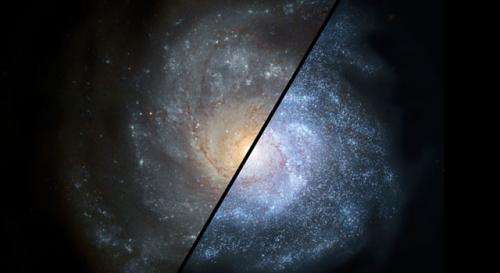Spitzer finds distant galaxies grazed on gas

(PhysOrg.com) -- Galaxies once thought of as voracious tigers are more like grazing cows, according to a new study using NASA's Spitzer Space Telescope.
Astronomers have discovered that galaxies in the distant, early universe continuously ingested their star-making fuel over long periods of time. This goes against previous theories that the galaxies devoured their fuel in quick bursts after run-ins with other galaxies.
"Our study shows the merging of massive galaxies was not the dominant method of galaxy growth in the distant universe," said Ranga-Ram Chary of NASA's Spitzer Science Center at the California Institute of Technology in Pasadena, Calif. "We're finding this type of galactic cannibalism was rare. Instead, we are seeing evidence for a mechanism of galaxy growth in which a typical galaxy fed itself through a steady stream of gas, making stars at a much faster rate than previously thought."
Chary is the principal investigator of the research, appearing in the Aug. 1 issue of the Astrophysical Journal. According to his findings, these grazing galaxies fed steadily over periods of hundreds of millions of years and created an unusual amount of plump stars, up to 100 times the mass of our sun.
"This is the first time that we have identified galaxies that supersized themselves by grazing," said Hyunjin Shim, also of the Spitzer Science Center and lead author of the paper. "They have many more massive stars than our Milky Way galaxy."
Galaxies like our Milky Way are giant collections of stars, gas and dust. They grow in size by feeding off gas and converting it to new stars. A long-standing question in astronomy is: Where did distant galaxies that formed billions of years ago acquire this stellar fuel? The most favored theory was that galaxies grew by merging with other galaxies, feeding off gas stirred up in the collisions.
Chary and his team addressed this question by using Spitzer to survey more than 70 remote galaxies that existed 1 to 2 billion years after the Big Bang (our universe is approximately 13.7 billion years old). To their surprise, these galaxies were blazing with what is called H alpha, which is radiation from hydrogen gas that has been hit with ultraviolet light from stars. High levels of H alpha indicate stars are forming vigorously. Seventy percent of the surveyed galaxies show strong signs of H alpha. By contrast, only 0.1 percent of galaxies in our local universe possess this signature.
Previous studies using ultraviolet-light telescopes found about six times less star formation than Spitzer, which sees infrared light. Scientists think this may be due to large amounts of obscuring dust, through which infrared light can sneak. Spitzer opened a new window onto the galaxies by taking very long-exposure infrared images of a patch of sky called the GOODS fields, for Great Observatories Origins Deep Survey.
Further analyses showed that these galaxies furiously formed stars up to 100 times faster than the current star-formation rate of our Milky Way. What's more, the star formation took place over a long period of time, hundreds of millions of years. This tells astronomers that the galaxies did not grow due to mergers, or collisions, which happen on shorter timescales. While such smash-ups are common in the universe -- for example, our Milky Way will merge with the Andromeda galaxy in about 5 billion years -- the new study shows that large mergers were not the main cause of galaxy growth. Instead, the results show that distant, giant galaxies bulked up by feeding off a steady supply of gas that probably streamed in from filaments of dark matter.
Chary said, "If you could visit a planet in one of these galaxies, the sky would be a crazy place, with tons of bright stars, and fairly frequent supernova explosions."
Provided by JPL/NASA


















